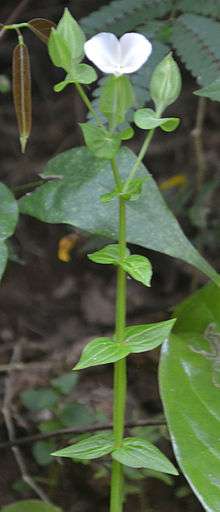Canscora alata
Canscora alata is a herbaceous species of plant in the family Gentianaceae, with a self-supporting growth habit. It is commonly known as samgamoli, kanjenkora, sangupushpi, sangupushpi, kanjenkora and samgamoli.[1] It is growing in moist deciduous forests, also in the plains. it is widely distributed in tropical Africa and South Asia.[2]
| Canscora alata | |
|---|---|
 | |
| Plant and flower from Kannavam forest. | |
| Scientific classification | |
| Kingdom: | Plantae |
| Clade: | Tracheophytes |
| Clade: | Angiosperms |
| Clade: | Eudicots |
| Clade: | Asterids |
| Order: | Gentianales |
| Family: | Gentianaceae |
| Genus: | Canscora |
| Species: | C. alata |
| Binomial name | |
| Canscora alata (Roth) Wall. | |
| Synonyms | |
| |
Description
Canscora alata is an erect herbs to 35 cm high; stem narrowly 4-winged. Leaves are 1.5-2.5 x 0.8-1.5 cm, elliptic-lanceolate, base rounded, apex acute, 3-nerved at base, subsessile. Cymes dichasial, axillary or terminal; pedicel 1-1.5 cm long, winged. Flowering and fruiting are from November to December. Seeds are angular.[3]
Uses
As an ayurvedic herb, Canscora alata is used for various diseases.
gollark: ++delete <@341618941317349376> for stalking and apparently now not being transparent about it.
gollark: <@341618941317349376> You have seriously just made the situation worse you idiot triangular.
gollark: RocketRace hasn't left.
gollark: I suspect it's just random bots running scans.
gollark: At least, the HTTP traffic looks normal.
References
- "Canscora alata (Roth) Wall. - Encyclopedia of Life". eol.org. Retrieved 2019-01-18.
- "Canscora alata (Roth) Wall. — The Plant List". www.theplantlist.org. Retrieved 2019-01-18.
- "Canscora decussata (Roxb.) Schult". India Biodiversity Portal. Retrieved 2019-01-18.

| Wikispecies has information related to Canscora alata |
This article is issued from Wikipedia. The text is licensed under Creative Commons - Attribution - Sharealike. Additional terms may apply for the media files.